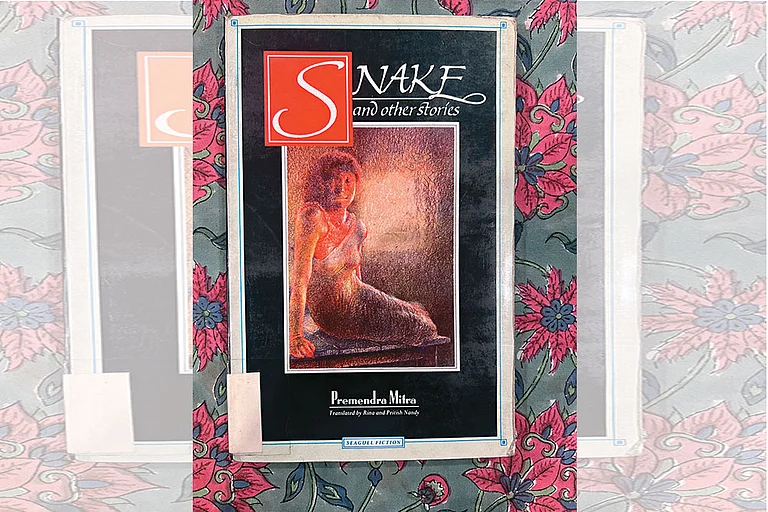Besides the lasting damage it causes to clusters of created memory that move and endure in society’s neural pathways, fake news can at times become a collective Freudian slip—an introduced error in the news cycle can reveal something society has actually tried to hide all along. One such instance broke into view, with some attendant verbal violence, during the recent Sabarimala temple entry flare-up. What has always been invisibilised, suppressed in visual form, came out in words. A local TV channel flashed the news that a young woman activist planned to desecrate Ayyappa’s shrine by smuggling in a sanitary pad soaked in menstrual blood in her pilgrim’s holy kit. The premise was extended when, based on this newsflash, textile minister Smriti Irani said “one would not take a sanitary pad soiled in blood to a friend’s place”. There you had it: two things were revealed at once. One, it put its finger on the nub of the male fear at Sabarimala. But more than that, this spoke the unspeakable. This was the exact thing that had all along made us resort to a whole bag of censoring ruses—to evade, elide, skirt around. Be it in the blue ink metaphor of sanitary pad ads or the uncountable euphemisms used to refer to womens’ monthly cycle of bleeding in all of world’s languages. Now, ‘sanitary pad soaked in blood’ became a national meme. These were mere words, but they carried an unmistakable graphic quotient—meant to repulse, almost weaponising the blood-soaked pad, an everyday object of women. The activist was imagined as planning an attack into an exclusionary sacred space, smuggling a pad like a gun or a grenade.
Is just the mention of that visual so explosive for the public space? Recent fantasies, or rather anxieties, around the idea of the ‘feminazi’—casual, misplaced epithet—may have something to do with it in this case. Imagine, then, an activist-trooper armed with a bloody pad, ready to breach fortress Sabarimala! For, the celibate male deity had by then been granted a citadel wall of ‘non-menstruating humans’.

A menstruating Brooke Shields as Emmeline in Blue Lagoon (1980)
Even outside of that festival of anxieties, the landscape over the past couple of years has been marked by a series of visual detonations. Each one confronted, in its own way, the unconscious codes that govern what is kosher and acceptable when it comes to menstruation, that universal, biological, ‘living’ topic that remains taboo in various spaces, in equally varied ways. In each case, repression begat a defiant mini-insurrection. The urge to break the suppressed silence visually always existed, of course, as with Judy Chicago’s 1971 art work ‘Red Flag’ (see It’s Bloody Art, Isn’t It!), but with the coming of the digital age, new spaces have opened up, well beyond the art world. This is especially so in India’s context. You can see the dots link up in our overlapping maps of multiple realities: Instagram, Facebook, India’s streets and universities, the PM’s postbox, and as far afield as New York’s subways.
The first noticeable ‘detonation’ came rather innocuously, in March 2015, with an Instagram upload by Indian-origin Canadian poet Rupi Kaur. A click from her photo-series titled Period, which depicted stains of menstrual blood—on a woman’s clothes and on her bedsheet—was taken down twice by Instagram because it supposedly violated its community standards, which generally pertain to nudity, gore and violence—that’s when people realised the menstruation taboo even existed on that visual platform for Generation Z. The inevitable happened: the silencing itself made a loud sound. After critical headlines, Instagram restored the image, with an apology to Kaur. The image has since gone viral, spilling to Ted talks, magazines and blogs, becoming a constant internet footnote on the subject.

Rupa Ganguly in Rituparno Ghosh’s Antarmahal (2005)
Part of a college project, Kaur’s photo-series had meant to resist the visual taboo. But all she was expecting was the usual backlash from trolls. But the episode actually reaffirmed the value of the image, for her as for everyone else. Instagram, a platform that is said to induce ‘pressurisingly pretty’ pictures, itself had to rectify its initial discomfort with the topic.
Back home, in 2016, the spiralling debate around that viral Rupi Kaur post was to embolden another online endeavour. “I now felt social media was a good medium to make an impactful statement,” says Nikita Azad. Thus began her #HappyToBleed campaign on Facebook—irked by some atrocious comments by a Travancore Devaswom Board official about the desirability of a machine that could scan women for ‘purity’, i.e. to see if they were menstruating or not. Nikita invited women to post pictures holding sanitary pads with rebellious messages against the taboo. Hundreds of women joined the campaign; virality was again at hand. Azad, then a student at Punjabi University, Patiala, eventually became one of the petitioners in the case in the Supreme Court.
Since all debates are national debates these days, the Sabarimala issue, spilling past the local, has exhumed many anxieties around menstruation at a time when the space for discussions, of all political colours, is opening up. Interestingly, it has been an enabler of sorts, prompting people to visibilise menstruation in their own way.

Padmini Ray Murray’s game Darshan Diversion
Padmini Ray Murray remembered the temple board official’s comments during a game jam in 2016, an annual event where she and her team had to make a video game, the theme being ‘ritual’. Thus came about Darshan Diversion, a game where women try to climb up floors to reach the temple top, the passage blocked by priests ready to send them back if they are menstruating, indicated by a blinking red light. “This could be fun, I thought,” says Ray Murray, who also teaches at the Srishti School of Art, Design and Technology, Bangalore. The game wasn’t meant to be very public—you can’t buy it online. But it was showcased this October in the Bangalore edition of We The Women, a show created by journalist Barkha Dutt. Dutt tweeted about it, bringing it out in troll territory. “I also started getting trolled on Twitter after that,” says Ray Murray. The game had to be pulled out of the Mumbai edition of We The Women in November as things got volatile, both on Twitter and at Sabarimala.
But November saw the battle joined on another front. Standing in front of a red stage in Ernakulam, a few hundred people gave the cry Arppo Arthavam! (Malayalam for ‘Hurray Menstruation!’) The protest visuals included a wing-shaped flag made of sanitary pads. “The visuals were important, since the experience is always been kept in the dark,” says Malayalam writer C.S. Chandrika. Arppo also became a hashtag under which women were invited to share their stories about the stigma. In response, and complementing the celebratory aspect of the protest, young artists like Shehi Shafi drew the artwork this issue is using on the cover.

From the #HappyToBleed campaign
Away from the confrontations, we all have been witness to the visuality of menstruation evolving at its own pace, mindful of the reigning, and changing, notions of acceptability. “The idea introduces itself very casually in the household space,” says filmmaker-writer Paromita Vohra about sanitary pad ads on TV. “They help prompt a discussion without really putting anyone in a spot. In this sense, it’s interesting how the blue liquid on TV actually un-taboos menstruation.” Vohra thinks the coded, allusive visuality of these ads makes the idea more accessible to people by keeping things within the comfort zone.
The themes are broadening too, after almost two decades of the post-liberalisation ads: Whisper’s 2014 ‘Touch the Pickle’ campaign, for instance, addresses a common menstruation myth. Then you have something like Padman, the Akshay Kumar starrer inspired by the innovation of Arunachalam Murugananthan. That also brought discussions to the most unusual of places—such as reality TV, during the film promos.
“There are also spaces like Menstrupedia, which further relax things,” says Vohra, of a website that seeks to spread awareness and break taboos around the subject with videos, posters and, recently, a comic book. “We are trying to change the narrative by portraying periods in a positive light,” says Aditi Gupta, Menstrupedia’s founder. “Since our visuals are positive, we don’t shy away from showing blood either,” she adds.

A poster of Period. End of Sentence, a film by Rayka Zehtabchi, which has made it to the Oscars
So, spaces for discussion are opening up in non-confrontational ways too. But stigma has a way of cornering your everydayness, almost demanding and in turn generating a mass of critical response: Kaur’s post was a regular one until Instagram made it the issue; Ray Murray’s game was a fun, critical take in internal gaming circles that got pulled into the Twitter troll vortex and the often-outrageous comments around Sabarimala prompted protests like #Happytobleed and #arppoarthavam.
“Women will make art out of the materiality of their lives,” says Vohra. She refers to the ‘pads against sexism’ protest in Jamia Milia Islamia in March 2015, where students wrote anti-sexist comments on sanitary pads and stuck them around the campus. “As you get into spaces where you can be more vocal, your level of engagement becomes more detailed,” adds Vohra.
Visuals also set precedents. When the government imposed a luxury tax on sanitary napkins in their initial GST policy, university students wrote messages on pads and mailed them to the PM and the FM. That was about economic policy interfering in everyday reality. The next one that tries to suppress this evolving narrative will engender another form of visible resistance. Watch out for these spaces, and junk the squirmy taboo pickle.

























